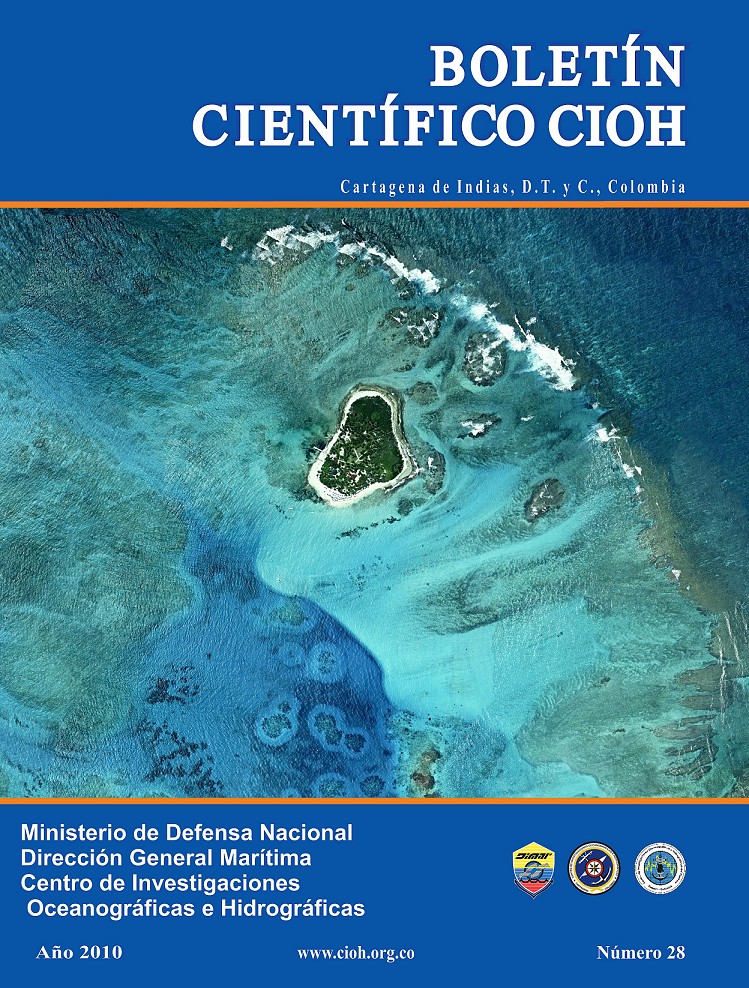Geochemestry and heavy metals concentrations in a comer-cial importance organism (Corbula caribaea. D’orbigny, 1842) in shallow subtidal zone at the Mallorquín-Atlántico Coastal lagoon
DOI:
https://doi.org/10.26640/22159045.216Keywords:
Lagoon coastal, Ciénaga de Mallorquín, sediments, heavy metals, Corbula caribaea, bioaccumulationAbstract
Geochemestry and concentrations of heavy metals (Cu, Cd, Pb, Zn) were measured in shallow subtidal sediments and in a comercial importance organism at the Mallorquín coastal lagoon, very important for the enviroment in departamento del Atlántico. Sediments and bivalves Corbula caribaea known as chipichipi was collected during the rainy and dry season. The sediments consist mainly of mud and show a strong concentration of organic matter (13%). The total heavy metal concentrations in sediments and tissues were analyzed by atomic absorption spectrophotometry. The sediments was collected only once time and the essential metals showed higher concentrations in the sediment that non-essential metals (Zn> Cu> Pb> Cd), however the contamination factor indicated absence or low degree of metal contamination. Zn as in sediment showed the highest concentrations in soft tissues for the two periods, Cu presented the highest value during the first sampling and was associated with the reproductive physiology of this specie. Cd had higher concentrations during the second sampling but Pb remained the lowest concentrations in all samples. The bioaccumulation factor showed that the species bioconcentrates significant traces of bioavailable Cd and Zn in the environment. This bioavailability was associated with salinity levels varied during the two periods sampled.Downloads
References
[2] León, I. Y Padilla, K. Geoquímica y contaminación por metales pesados (Fe, Cu, Pb y Zn) en sedimentos intermareales y submareales en la Ciénaga de Mallorquín (Barranquilla-Colombia). Memorias del III Simposio Internacional de Medio Ambiente, ISBN 959-7145-04-9. La Habana, Cuba 7-10 de julio de 2008.
[3] INVEMAR. Metales pesados en agua, sedimento y organismos de la ciénaga de Mallorquín – Departamento del Atlántico. Informe Técnico: 2005;12 p.
[4] Guven D. Y Akinci G. Heavy metals partitioning in the sediments of Izmir Inner Bay. Journal of Environmental Sciences 2008(20); 413–418.
[5] Giarratano, E., Amin, O.A., Heavy metals monitoring in the southernmost mussel farm of the world (Beagle Channel, Argentina). Ecotoxicology Environmental Safety 2010(doi:10.1016/j.ecoenv.2010.06.023).
[6] León I, Méndez G, Rubio B. Fases geoquímicas del Fe y grado de piritización en sedimentos de la Ría de Pontevedra (NO de España): implicaciones del cultivo del mejillón en bateas. Ciencias Marinas 2004; 30(4): 585-602.
[7] Whitfield J. Vital Sings. Nature 2001(411): 989- 990.
[8] Díaz M, Riba I, Martinez C, Delvalls A. Biodisponibilidad de metales en sedimentos de estuarios españoles utilizando Carcinus maenas. Ciencias Marinas 2006; 32(2B): 412-420.
[9] Yap K, Ismail A, Tan G, Rahim A. Assessment of different soft tissues of the gree-lipped mussel Perna viridis (Linnaeus) as biomonitoring agents of Pb: field and laboratory studies. Water, air, and soil pollution 2006; 153: 253-268.
[10] Guitián F, Carballas T. Técnicas de Análisis de Suelos. Santiago de Compostela: Pico Sacro 2006; 288p.
[11] Mc Crath, S. Y Cunliffe, C. A simplified method for the extraction of the metals Fe, Zn, Ni, Pb, Cr, Co, and Mn from soils and sewage sludges. J. Sci. Food Agric. 1985; 36, 794-798.
[12] Acosta V, Lodeiros C. Metales pesados en la almeja Tivela Mactroides Born, 1778 (Bivalvia: Veneridae) en localidades costeras con diferentes grados de contaminación en Venezuela. Ciencias marinas 2004; 30(2): 323-333.
[13] Sierra, F. Cantidad de metales pesados (Cobre, Cadmio y Zinc) en la lisa (Mungilincilis) en la ciénaga de Mallorquín Atlántico. Trabajo de Grado. Universidad del Atlántico, Facultad de Ciencias Básicas 2002.
[14] Campos N. La ostra comercial de la ciénaga de Santa Marta crassostrea rhizophorae y la problemática de la conta-minación por metales. TRIANEA (Acta. Científica. Técnica. INDERENA) 1991; 4: 623-631.
[15] Zhao H. Xunyong L, Xiaomei W. Grain size distribution of road-deposited sediment and its contribution to heavy metal pollution in urban runoff in Beijing, China, J. Hazardous Materials. 2010 (doi:10.1016/j.jhazmat.2010.07.012).
[16] George S., S. Pirie, A. Cheyne, T. Coombs Y Grant. T. Detoxification of metals by marine bivalves: an ultrastructural study of the compartmentation of copper and zinc in the oyster Ostrea edulis. Mar. Biol. 1978;45: 147-156.
[17] Maanan M. Heavy metal concentrations in marine molluscs from the Moroccan coastal region. Environmental Pollution. 2008(153); 176-183.
[18] Castillo, I., Acosta, V., Martinez, G. Y Núñez, M. Niveles de metales pesados en gónadas y músculo aductor del mejillón marrón, Perna perna, cultivado en la ensenada de Turpialito, Golfo de Cariaco, estado Sucre, Venezuela. Zoo-tecnia Tropical 2005;23(2):141-154.
[19] Förstner U. Y W. Salomons. freistzung schädlicher Meta-llverbindungenaus Sedimenten. Geowissenschaften in inserer Zeit. 1. Jahrg. 1983;2: 37-45.
[20] Ministerio de Agricultura. Decreto 1594: Usos del Agua y Residuos líquidos. Diario Oficial N° 36.700 del 26 de Junio del 1984.
[21] Van Der Oost, Beyer J. Fish bioacumulation and biomarkers in envairomental risk assessment. Enviromental toxi-Enviromental toxicology and farmacology. 2003;13:57-149.
[22] Förstner U. Y W. Salomons. Freistzung schädlicher Metall-verbindungenaus Sedimenten. Geowissenschaften in in-serer Zeit. 1. Jahrg. 1983;2: 37-45.
[23] Phillips, D. Quantitative aquatic biological indicators. Their use to monitor trace metal an organochlorine pollution. Applied Science Publications Ltd. London 1980;488 p.
[24] Pedro S., Canastreiro V., Cacador I., Pereira E., Duarte A., Raposo P. Granulometric selectivity in Liza ramado and potential contamination resulting from heavy metal load in feeding areas. Estuarine, Coastal and Shelf Science 2008;80: 281–288.
Downloads
Published
Issue
Section
License
Attribution — You must give appropriate credit, provide a link to the license, and indicate if changes were made. You may do so in any reasonable manner, but not in any way that suggests the licensor endorses you or your use.
NonCommercial — You may not use the material for commercial purposes.
NoDerivatives — If you remix, transform, or build upon the material, you may not distribute the modified material.
No additional restrictions — You may not apply legal terms or technological measures that legally restrict others from doing anything the license permits.



